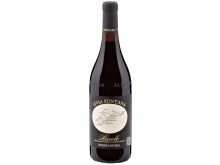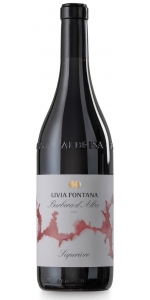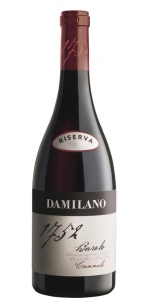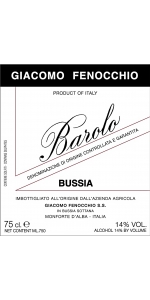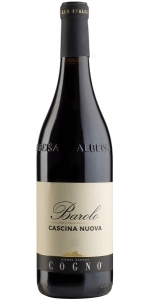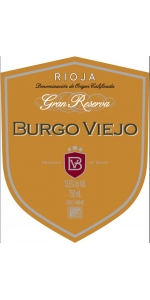Livia Fontana Barolo Riserva Bussia 2013
| Country: | Italy |
| Regions: | Piemonte Barolo |
| Winery: | Livia Fontana |
| Grape Type: | Nebbiolo |
| Vintage: | 2013 |
| Bottle Size: | 750 ml |
Livia Fontana Barbera d'Alba Superiore is made from 100 percent Barbera.
Organoleptic characteristics: intense ruby red color. Fresh and intense aromas with currants and berries notes. Warm, full, rich and persistent taste, full body. Suitable for long aging.
Excellent accompaniment to warm appetizers, rich first courses, red meat and the medium-seasoned cheeses.
Livia Fontana Barbera d'Alba Superiore is made from 100 percent Barbera.
Organoleptic characteristics: intense ruby red color. Fresh and intense aromas with currants and berries notes. Warm, full, rich and persistent taste, full body. Suitable for long aging.
Excellent accompaniment to warm appetizers, rich first courses, red meat and the medium-seasoned cheeses.
“1752” is the name of the Damilano Barolo Cannubi Riserva, in honor of the year in which the historic bottle was first marked “Cannubi”. It still exists today perfectly conserved by the Manzone family in Bra, close to Barolo. The bottle is clearly marked as being of “1752” vintage, indicating that Cannubi historically precedes Barolo.
About the Vineyard:
The Cannubi Cru is in found within one of the 6 core zones which comprise a UNESCO heritage site in Italy. A mixture of Tortonian and Helvetian calcareous marl gives the grapes intense aromas of cherry, plum and tobacco, rose and violet in sequence. Its low potassium and high calcium/magnesium content offer the wine a fine and polished touch. The vineyard is located at about 270 m. a.s.l. and has a south-east sun exposure. Barolo Riserva Cannubi 1752 It is a small plot of about 2 hectares of Nebbiolo vines, currently between 30 and 50 years of age.
Tasting Notes:
Garnet ruby red in color, the bouquet is intense and balanced, with notes of violet, red fruit, cherry and plum, spices, liquorice, cocoa, leather and tobacco. Dry, robust, full-bodied, very persistent, rich and velvety
Food Pairing:
This wine is excellent with typical piedmontes pasta (tajarin, ravioli); perfect with red meat, braised and roast meat, game and absolutely ideal with all types of cheeses.
Review:
The purity of this wine is pretty phenomenal with blackberries, strawberries, fresh flowers and licorice. Hints of tar. It’s full-bodied, yet composed and compact with ultra fine tannins and a long, flavorful finish. Very structured. Try after 2024.
-James Suckling 97 Points
“1752” is the name of the Damilano Barolo Cannubi Riserva, in honor of the year in which the historic bottle was first marked “Cannubi”. It still exists today perfectly conserved by the Manzone family in Bra, close to Barolo. The bottle is clearly marked as being of “1752” vintage, indicating that Cannubi historically precedes Barolo.
About the Vineyard:
The Cannubi Cru is in found within one of the 6 core zones which comprise a UNESCO heritage site in Italy. A mixture of Tortonian and Helvetian calcareous marl gives the grapes intense aromas of cherry, plum and tobacco, rose and violet in sequence. Its low potassium and high calcium/magnesium content offer the wine a fine and polished touch. The vineyard is located at about 270 m. a.s.l. and has a south-east sun exposure. Barolo Riserva Cannubi 1752 It is a small plot of about 2 hectares of Nebbiolo vines, currently between 30 and 50 years of age.
Tasting Notes:
Garnet ruby red in color, the bouquet is intense and balanced, with notes of violet, red fruit, cherry and plum, spices, liquorice, cocoa, leather and tobacco. Dry, robust, full-bodied, very persistent, rich and velvety
Food Pairing:
This wine is excellent with typical piedmontes pasta (tajarin, ravioli); perfect with red meat, braised and roast meat, game and absolutely ideal with all types of cheeses.
Review:
“Incredible, reserved ripeness and depth already evident on the nose after one whiff, offering plum, cedar, rose hip, sandalwood, and licorice. Full-bodied with superb depth of fruit and an abundance of polished tannins that give the wine poise and grace, even though it’s long and powerful. The quality of the tannins are exceptional. Sheer and refined. This comes from the center of Cannubi.”
-James Suckling 99 Points
“1752” is the name of the Damilano Barolo Cannubi Riserva, in honor of the year in which the historic bottle was first marked “Cannubi”. It still exists today perfectly conserved by the Manzone family in Bra, close to Barolo. The bottle is clearly marked as being of “1752” vintage, indicating that Cannubi historically precedes Barolo.
About the Vineyard:
The Cannubi Cru is in found within one of the 6 core zones which comprise a UNESCO heritage site in Italy. A mixture of Tortonian and Helvetian calcareous marl gives the grapes intense aromas of cherry, plum and tobacco, rose and violet in sequence. Its low potassium and high calcium/magnesium content offer the wine a fine and polished touch. The vineyard is located at about 270 m. a.s.l. and has a south-east sun exposure. Barolo Riserva Cannubi 1752 It is a small plot of about 2 hectares of Nebbiolo vines, currently between 30 and 50 years of age.
Tasting Notes:
Garnet ruby red in color, the bouquet is intense and balanced, with notes of violet, red fruit, cherry and plum, spices, liquorice, cocoa, leather and tobacco. Dry, robust, full-bodied, very persistent, rich and velvety
Food Pairing:
This wine is excellent with typical piedmontes pasta (tajarin, ravioli); perfect with red meat, braised and roast meat, game and absolutely ideal with all types of cheeses.
Review:
Fenocchio DOCG Bussia Barolo is made from 100 percent Nebbiolo
The color is deep garnet red and the bouquet is fine and pleasing, with intense scents of spiced rose and licorice. The flavor is dry, warm, full bodied and balanced with pronounced tannins and a persistent aftertaste. A wine particularly adapted for aging.
Traditional method of long maceration: natural fermentation without added yeasts for 30 days in stainless steel tanks.
The Barolo Bussia, with its structure and body characteristics, pairs well with dishes of meat, game and aged cheeses, typical dishes of the local cuisine, as well as with many rich international dishes.
Review:
" Pleasant dried-cherry aromas, colored with nutty spice and dried leaves. Full-to medium-bodied with fine, firm and velvety tannins and a long finish of candied-cherry and chocolate. Give it a few years to meld together better. Best from 2025."
- James Suckling (January 2022), 93 pts
Livia Fontana Barolo Riserva Bussia is made from 100 percent Nebbiolo.
Organoleptic characteristics: garnet red color. Intense and balanced, harmonious bouquet. Pleasantly dry, full and velvety on the palate. A classic Barolo with a very elegant and persistent finish.
The grapes for this wine are coming from a vineyard that is located in the historical part of Bussia called "Le Munie"
Review:
"Truffle, rose, camphor, wild berry and botanical herb are just some of the aromas you'll find on this. Full bodied and youthfully austere, the palate has firm structure and tension, delivering dried cherry, licorice, tobacco and blood orange framed in tightly knit, close-grained tannins. Fresh acidity keeps it balanced. Drink 2023–2033. - Kerin O'KEEFE" - Wine Enthusiast Magazine (December 1st 2019), 93 pts
Livia inherited the passion for viticulture from her father Ettore and she in her turn transmits with love and enthusiasm the values of those who preceded her in these vineyards. After more than two hundred years, the blood and fiber of the company are still united and today carried forward by the eighth generation while maintaining the history of the family’s objectives made with seriousness, commitment and love of the earth.
The Livia Fontana winery is a rare case in which business and family blend together blurring the boundaries of both, becoming an example of how the convergence of objectives makes the family united and the company successful. The winery is managed by Livia Fontana and her two sons, Michele and Lorenzo, who have been preceded by seven generations of the Fontana family. Each with their own roles brings energy, enthusiasm, competence and passion. The result is excellent wines that are appreciated throughout the world for the way in which tradition and new technologies merge in products of very high quality.
Elvio Cogno Cascina Nuova Barolo 2017
Born to satisfy the curiosity of consumers keen to have a more immediate understanding of Barolo, the wine is bright garnet red in color with orange tints. Pleasing and immediate, it offers scents of flowers and light, delicate spices. The mouth is agreeably rounded, juicy and fresh, with just the right balance between pleasantness and elegance. The aftertaste is very harmonious with a mineral, aromatic finish.
Review:
Attractive dried strawberry with cherry and tar on the nose. Full-bodied with powerful tannins that are dusty and intense. Very flavorful and long. Solid as a rock. Needs at least three or four years to soften and come together.
-James Suckling 95 Points
Burgo Viejo Rioja Gran Reserva is made from 100 percent Tempranillo. 30 year old vines.
Burgo Viejo Gran Reserva shows a deep red ruby color and offers powerful aromas of blackberry jam, spice, leather, chocolate with toasty nuances. Smooth yet full-bodied with firm tannins and a long finish.
Review:
"Shimmering garnet. Aromas of cherry, blueberry, candied flowers, tobacco and coconut pick up a smoky overtone with air. Smooth and fleshy on the palate, offering ripe red and blue fruit, mocha, cola and spicecake qualities that tighten up on the back half. Finishes long and supple with repeating spiciness, even tannins and a lingering suggestion of red berry preserves. This old-school Rioja was aged for two years in 90% American and 10% French oak. - Josh Raynolds"
- Antonio Galloni's Vinous (April 2021), 92 pts
2010 Burgo Viejo Rioja Gran Reserva - Silver Medal - MUNDUS VINI
- back
Stonestreet Estate Vineyards Rockfall Cabernet Sauvignon is made from Cabernet Sauvignon.
Sourced from one of our highest elevation vineyards, the 2017 Rockfall Vineyard Cabernet Sauvignon features a true wildness that expresses the rugged growing site 2,000ft above the fog line. Elegant aromas of blueberries, cassis, graphite and black tea with complex undercurrents of baking spices. This wine balances power with elegance through to its savory palate with a generous structure and ample tannins. The structure of this wine allows for many years of cellar aging to continue to bring out nuanced flavors and complexity.
Review:
The Rockfall Vineyard is between 2,000 and 2,200-feet in elevation, and the wine that originates there is powerful and concentrated in style, with robust red-fruit and mineral tones. Herbal and classic, it shows elegance and integrated oak and tannin within its context of intensity and structure. Enjoy best from 2027–2037. Virginie Boone
-Wine Enthusiast 96 Points
Manoir du Carra Bistrot Beaujolais-Villages is made from 100 percent Gamay.
From Granitic and sandy soils, the Beaujolais-Villages Carra Bistrot exhibits intense color, with hints of cherry and garnet, and to reveal aromas of red fruit dominated by cassis and strawberry. This Cuvée was specially made for the Parisian Bistrots willing to offer easy drinking wines, with enough body to withstand local Cuisine from the Beaujolais region.
Produced from a selection of old vines (50-70 years old). Manual harvest; selection of the best grapes using a sorting table; semi-carbonic maceration for 10-12 days. No filtration. Egg white fining.
Great with coq au vin (Chicken cooked in a red wine sauce) or charcuterie (garlic sausage, dry sausage).

